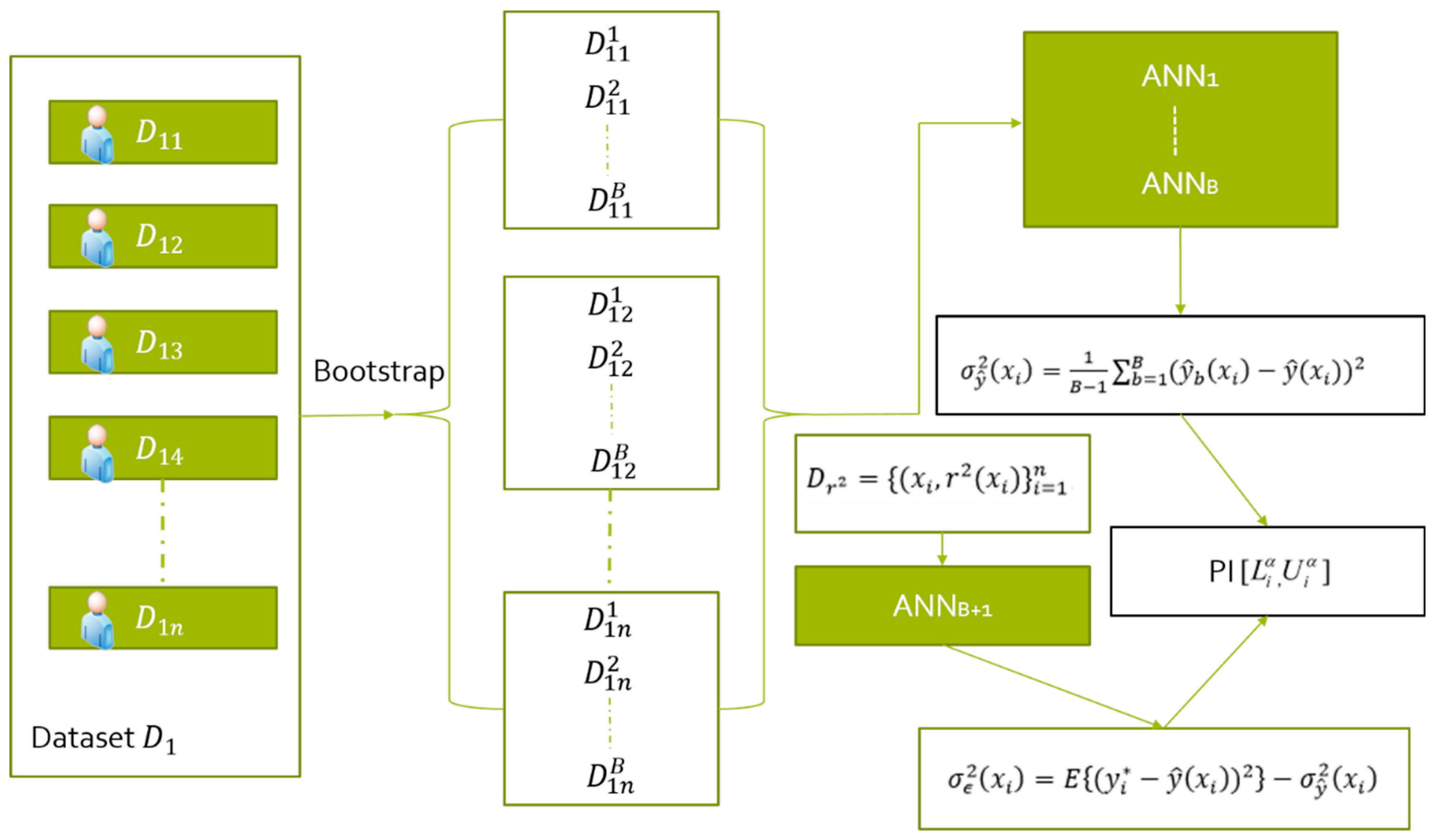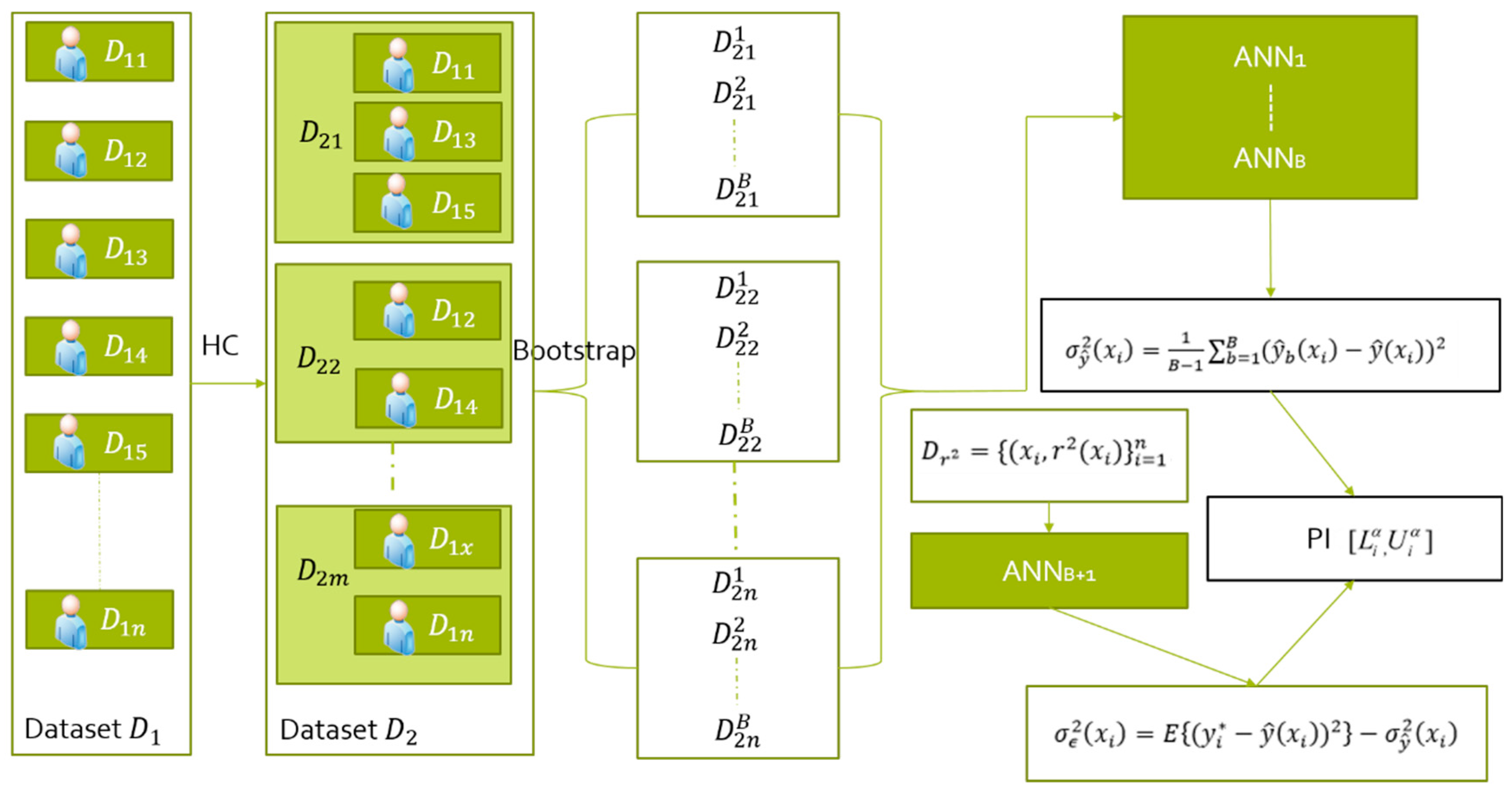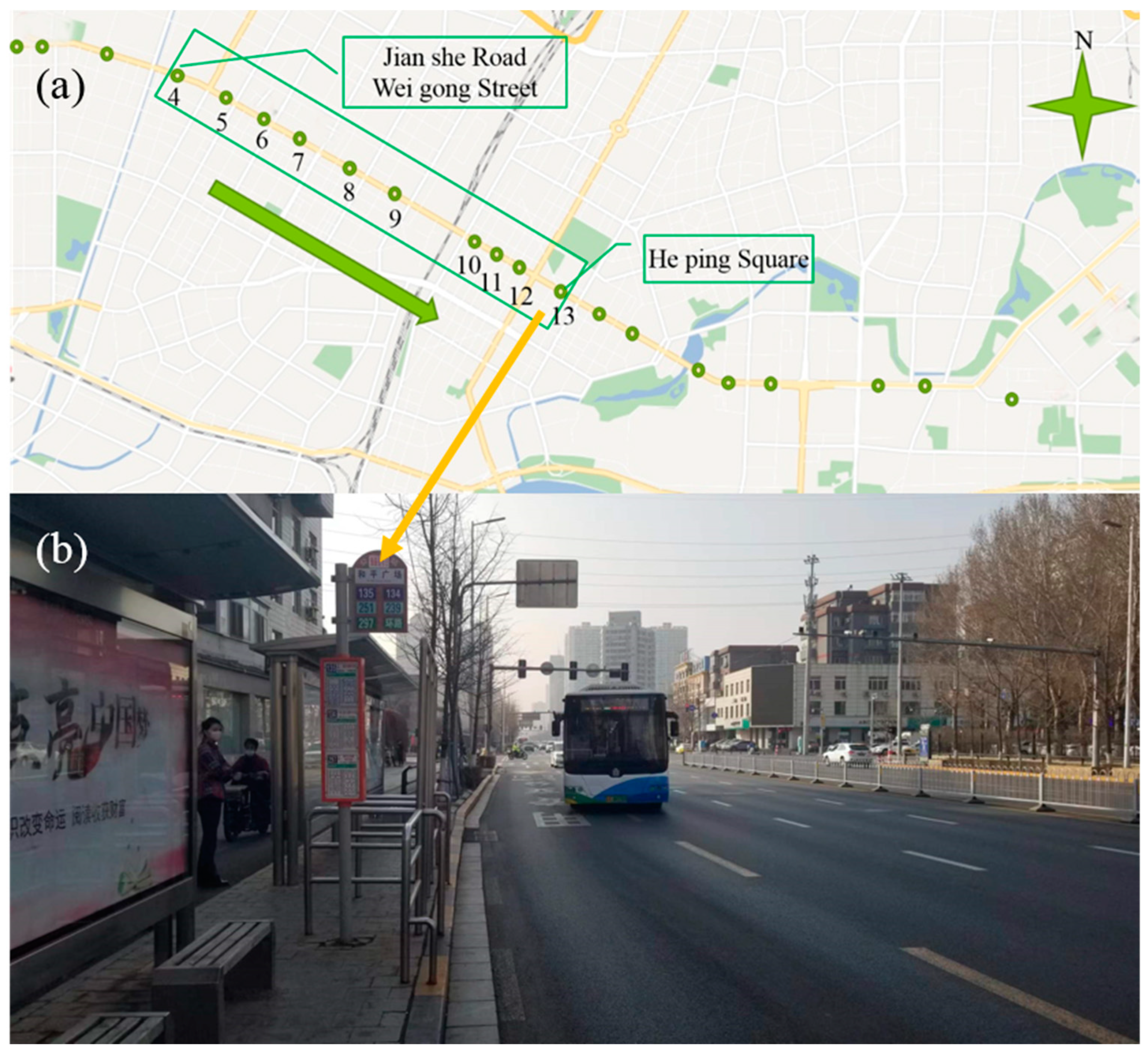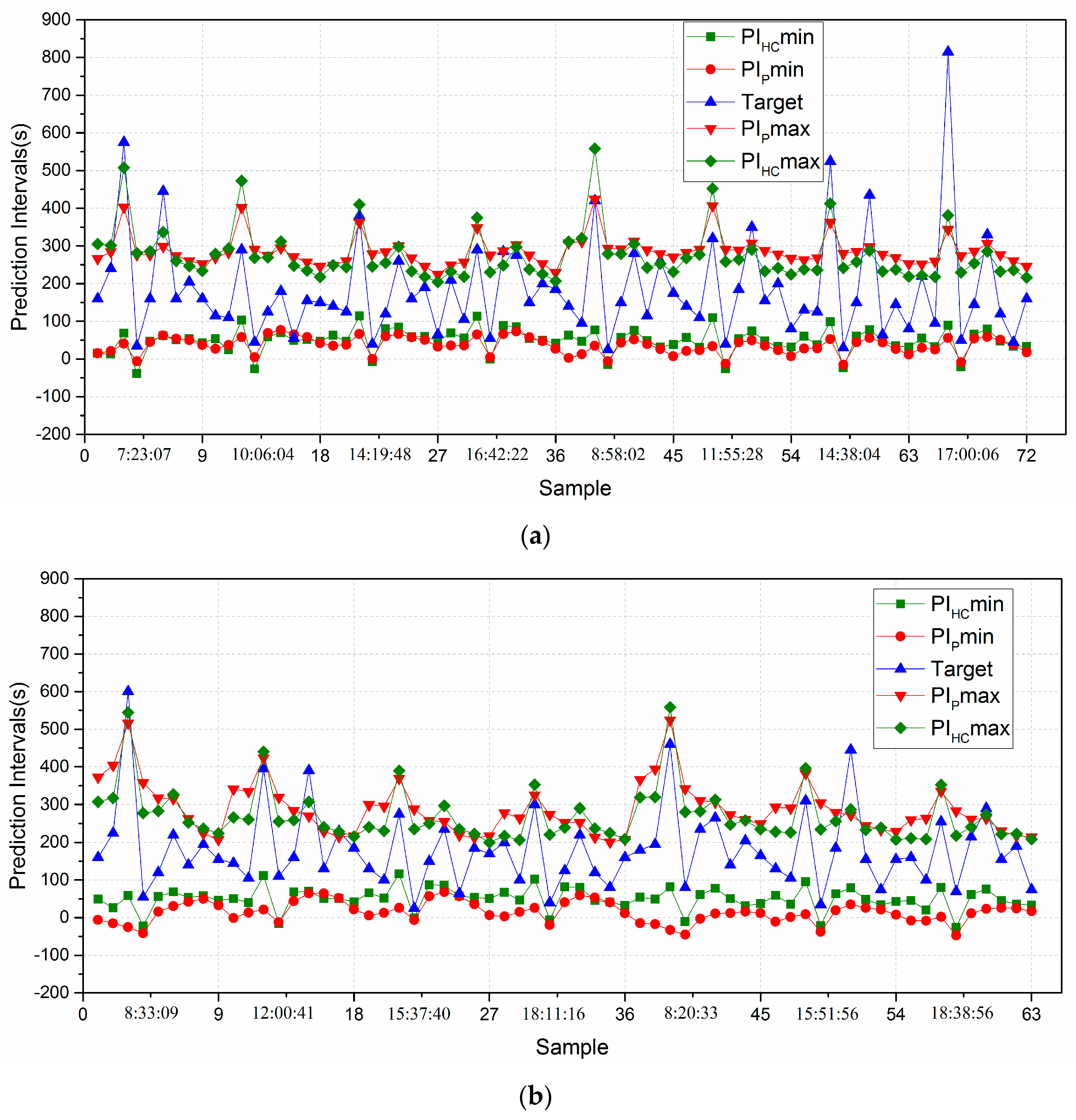Construction of Personalized Bus Travel Time Prediction Intervals Based on Hierarchical Clustering and the Bootstrap Method
Abstract
1. Introduction
- We establish a personalized bus travel time PI model based on the bootstrap method for drivers with different driving styles. The proposed model can provide accurate and stable prediction results.
- To the best of our knowledge, this paper is the first to study the influence of driving style factors on the quality of bus travel time PIs.
- In order to improve the quality of PIs, we use the hierarchical clustering method to cluster the travel time data sets of multiple different drivers according to driving style, and further optimize the quality of personalized travel time PIs based on the bootstrap method.
2. Related Works
2.1. Review of Classification of Driver’s Driving Style Research
2.2. Review of PI Forecasting Literature
3. Bootstrap Method for PI Construction
4. Methodology
4.1. Framework
4.2. Driver Driving Style Classification
| Algorithm 1 Hierarchical Clustering Algorithm |
| Compute the proximity matrix. |
| Repeat |
| Merge the closest two clusters. |
| Update proximity matrix. |
| Until only one cluster remains. |
4.3. Bus Travel Time Prediction
5. Experiments and Results
5.1. Data Collection
5.2. Driving Style Clustering of Bus Drivers
5.3. PI Assessment Indexes
5.4. Results and Discussions
6. Conclusions
Author Contributions
Funding
Data Availability Statement
Conflicts of Interest
References
- Denant-BoFmont, L.; Petiot, R. Information value and sequential decision-making in a transport setting: An experimental study. Transp. Res. Part B Meth. 2003, 37, 365–386. [Google Scholar] [CrossRef]
- Bhat, C.R.; Sardesai, R. The impact of stop-making and travel time reliability on commute mode choice. Transp. Res. Part B Meth. 2006, 40, 709–730. [Google Scholar] [CrossRef][Green Version]
- Khosravi, A.; Mazloumi, E.; Nahavandi, S.; Creighton, D.; Van Lint, J.W.C. A genetic algorithm-based method for improving quality of travel time prediction intervals. Transp. Res. Part C Emerg. Technol. 2011, 19, 1364–1376. [Google Scholar] [CrossRef]
- Shalaby, A.; Farhan, A. Bus travel time prediction model for dynamic operations control and passenger information systems. In Proceedings of the 82nd Annual Meeting of the Transportation Research Board, Washington, DC, USA, 12–16 January 2003. [Google Scholar]
- He, P.; Jiang, G.; Lam, S.K.; Sun, Y. Learning heterogeneous traffic patterns for travel time prediction of bus journeys. Inf. Sci. 2020, 512, 1394–1406. [Google Scholar] [CrossRef]
- Huang, Y.P.; Chen, C.; Su, Z.C.; Chen, T.S.; Sumalee, A.; Pan, T.L.; Zhong, R.X. Bus arrival time prediction and reliability analysis: An experimental comparison of functional data analysis and Bayesian support vector regression. Appl. Soft Comput. 2021, 111, 107663. [Google Scholar] [CrossRef]
- Kumar, B.A.; Vanajakshi, L.; Subramanian, S.C. Bus travel time prediction using a time-space discretization approach. Transp. Res. Part C Emerg. Technol. 2017, 79, 308–332. [Google Scholar] [CrossRef]
- Hua, X.; Wang, W.; Wang, Y.; Ren, M. Bus arrival time prediction using mixed multi-route arrival time data at previous stop. Transport 2017, 33, 543–554. [Google Scholar] [CrossRef][Green Version]
- Ma, Z.; Koutsopoulos, H.N.; Ferreira, L.; Mesbah, M. Estimation of trip travel time distribution using a generalized Markov chain approach. Transp. Res. Part C Emerg. Technol. 2017, 74, 1–21. [Google Scholar] [CrossRef]
- Yuan, Y.; Shao, C.; Cao, Z.; He, Z.; Zhu, C.; Wang, Y.; Jang, V. Bus Dynamic Travel Time Prediction: Using a Deep Feature Extraction Framework Based on RNN and DNN. Electronics 2020, 9, 1876. [Google Scholar] [CrossRef]
- Bie, Y.; Wang, D.; Qi, H. Prediction Model of Bus Arrival Time at Signalized Intersection Using GPS Data. J. Transp. Eng. 2012, 138, 90–97. [Google Scholar] [CrossRef]
- Chow, A.H.F.; Li, S.; Zhong, R. Multi-objective optimal control formulations for bus service reliability with traffic signals. Transp. Res. Part B Method. 2017, 103, 248–268. [Google Scholar] [CrossRef]
- Yu, B.; Wang, H.; Shan, W.; Yao, B. Prediction of bus travel time using random forests based on near neighbors. Comput. Aided Civ. Infrastruct. Eng. 2017, 33, 333–350. [Google Scholar] [CrossRef]
- Wei, M.; Liu, X. How wet is too wet? Modelling the influence of weather condition on urban transit ridership. Travel Behav. Soc. 2022, 27, 117–127. [Google Scholar] [CrossRef]
- Reddy, K.K.; Kumar, B.A.; Vanajakshi, L. Bus travel time prediction under high variability conditions. Curr. Sci. 2016, 111, 700–711. [Google Scholar] [CrossRef]
- O’Sullivan, A.; Pereira, F.C.; Zhao, J.; Koutsopoulos, H.N. Uncertainty in Bus Arrival Time Predictions: Treating Heteroscedasticity with a Metamodel Approach. IEEE Trans. Intell. Transp. Syst. 2016, 17, 3286–3296. [Google Scholar] [CrossRef][Green Version]
- Fan, W.; Gurmu, Z. Dynamic Travel Time Prediction Models for Buses Using Only GPS Data. Int. J. Transp. Sci. Technol. 2015, 4, 353–366. [Google Scholar] [CrossRef]
- Yu, B.; Lam, W.H.K.; Tam, M.L. Bus arrival time prediction at bus stop with multiple routes. Transp. Res. Part C Emerg. Technol. 2011, 19, 1157–1170. [Google Scholar] [CrossRef]
- Ma, J.; Chan, J.; Ristanoski, G.; Rajasegararet, S.; Leckieal, C. Bus travel time prediction with real-time traffic information. Transp. Res. Part C Emerg. Technol. 2019, 105, 536–549. [Google Scholar] [CrossRef]
- Mazloumi, E.; Rose, G.; Currie, G.; Moridpour, S. Prediction intervals to account for uncertainties in neural network predictions: Methodology and application in bus travel time prediction. Eng. Appl. Artif. Intell. 2011, 24, 534–542. [Google Scholar] [CrossRef]
- Khosravi, A.; Mazloumi, E.; Nahavandi, S.; Creighton, D.; Van Lint, J.W.C. Prediction intervals to account for uncertainties in travel time prediction. IEEE Trans. Intell. Transp. Syst. 2011, 12, 537–547. [Google Scholar] [CrossRef]
- Khosravi, A.; Nahavandi, S.; Srinivasan, D.; Khosravi, R. Constructing Optimal Prediction Intervals by Using Neural Networks and Bootstrap Method. IEEE Trans. Neural Netw. Learn. Syst. 2015, 26, 1810–1815. [Google Scholar] [CrossRef] [PubMed]
- Van Lint, J.W.C. Reliable real-time framework for short-term freeway travel time prediction. J. Transp. Eng. 2006, 132, 921–932. [Google Scholar] [CrossRef]
- Lee, J.; Jang, K. A framework for evaluating aggressive driving behaviors based on in-vehicle driving records. Transp. Res. Part F Traf. 2019, 65, 610–619. [Google Scholar] [CrossRef]
- Martinez, C.M.; Heucke, M.; Wang, F.; Gao, B.; Cao, D. Driving Style Recognition for Intelligent Vehicle Control and Advanced Driver Assistance: A Survey. IEEE Trans. Intell. Transp. Syst. 2018, 19, 666–676. [Google Scholar] [CrossRef][Green Version]
- Eboli, L.; Mazzulla, G.; Pungillo, G. How drivers’ characteristics can affect driving style. Transp. Res. Procedia 2017, 27, 945–952. [Google Scholar] [CrossRef]
- Ekman, F.; Johansson, M.; Bligård, L.-O.; Karlsson, M.; Strömberg, H. Exploring automated vehicle driving styles as a source of trust information. Transp. Res. Part F Traf. 2019, 65, 268–279. [Google Scholar] [CrossRef]
- Murphey, Y.L.; Milton, R.; Kiliaris, L. Driver’s style classification using jerk analysis. In Proceedings of the 2009 IEEE Workshop on Computational Intelligence in Vehicles and Vehicular Systems, Nashville, TN, USA, 30 March–2 April 2009; pp. 23–28. [Google Scholar]
- Xu, L.; Hu, J.; Jiang, H.; Meng, W. Establishing style-oriented driver models by imitating human driving behaviors. IEEE Trans. Intell. Transp. Syst. 2015, 16, 2522–2530. [Google Scholar] [CrossRef]
- Hajiseyedjavadi, F.; Boer, E.R.; Romano, R.; Paschalidis, E.; Wei, C.; Solernou, A.; Forster, D.; Merat, N. Effect of environmental factors and individual differences on subjective evaluation of human-like and conventional automated vehicle controllers. Transp. Res. Part F Traf. 2022, 90, 1–14. [Google Scholar] [CrossRef]
- Mudgal, A.; Hallmark, S.; Carriquiry, A.; Gkritza, K. Driving behavior at a roundabout: A hierarchical Bayesian regression analysis. Transp. Res. Part D Transp. Environ. 2014, 26, 20–26. [Google Scholar] [CrossRef]
- Johnson, D.A.; Trivedi, M.M. Driving style recognition using a smartphone as a sensor platform. In Proceedings of the 2011 14th International IEEE Conference on Intelligent Transportation Systems (ITSC), Washington, DC, USA, 5–7 October 2011; pp. 1609–1615. [Google Scholar]
- Langari, R.; Won, J.S. Intelligent energy management agent for a parallel hybrid vehicle-part I: System architecture and design of the driving situation identification process. IEEE Trans. Veh. Technol. 2005, 54, 925–934. [Google Scholar] [CrossRef]
- Doshi, A.; Trivedi, M.M. Examining the impact of driving style on the predictability and responsiveness of the driver: Real-world and simulator analysis. In Proceedings of the 2010 IEEE Intelligent Vehicles Symposium, La Jolla, CA, USA, 21–24 June 2010; pp. 232–237. [Google Scholar]
- Miyajima, C.; Nishiwaki, Y.; Ozawa, K.; Wakita, T.; Itou, K.; Takeda, K.; Itakura, F. Driver modeling based on driving behavior and its evaluation in driver identification. Proc. IEEE 2007, 95, 427–437. [Google Scholar] [CrossRef]
- Constantinescu, Z.; Marinoiu, C.; Vladoiu, M. Driving style analysis using data mining techniques. Int. J. Comput. Commun. Control 2010, 5, 654–663. [Google Scholar] [CrossRef]
- Vaitkus, V.; Lengvenis, P.; Zylius, G. Driving style classification using long-term accelerometer information. In Proceedings of the 2014 19th International Conference on Methods and Models in Automation and Robotics (MMAR), Miedzyzdroje, Poland, 2–5 September 2014; pp. 641–644. [Google Scholar]
- Karginova, N.; Byttner, S.; Svensson, M. Data-Driven Methods for Classification of Driving Styles in Buses; SAE Technical Papers; SAE International: Warrendale, PA, USA, 2012; pp. 1–7. [Google Scholar]
- Augustynowicz, A. Preliminary classification of driving style with objective rank method. Int. J. Autom. Technol. 2009, 10, 607–610. [Google Scholar] [CrossRef]
- Khosravi, A.; Nahavandi, S.; Creighton, D. Quantifying uncertainties of neural network-based electricity price forecasts. Appl. Energy 2013, 112, 120–129. [Google Scholar] [CrossRef]
- Khosravi, A.; Nahavandi, S.; Creighton, D.; Atiya, A.F. Lower upper bound estimation method for construction of neural network-based prediction intervals. IEEE Trans. Neural Netw. 2011, 22, 337–346. [Google Scholar] [CrossRef] [PubMed]
- Khosravi, A.; Nahavandi, S.; Creighton, D.; Atiya, A. Comprehensive review of neural network-based prediction intervals and new advances. IEEE Trans. Neural Netw. 2011, 22, 1341–1356. [Google Scholar] [CrossRef]
- Efron, B.; Tibshirani, R.J. An Introduction to the Bootstrap; Chapman & Hall: New York, NY, USA, 1993. [Google Scholar]
- Lins, I.D.; Droguett, E.L.; Moura, M.D.C.; Zio, E.; Jacinto, C.M. Computing confidence and prediction intervals of industrial equipment degradation by bootstrapped support vector regression. Reliab. Eng. Syst. Saf. 2015, 137, 120–128. [Google Scholar] [CrossRef]
- Efron, B. Bootstrap methods: Another look at the jackknife. Ann. Stat. 1979, 7, 1–26. [Google Scholar] [CrossRef]
- Heskes, T. Practical confidence and prediction interval. In Advances in Neural Information Processing Systems; MIT Press: Cambridge, MA, USA, 1997; Volume 9, pp. 176–182. [Google Scholar]
- Khosravi, A.; Nahavandi, S.; Creighton, D. Construction of optimal prediction intervals for load forecasting problem. IEEE Trans. Power Syst. 2010, 25, 1496–1503. [Google Scholar] [CrossRef][Green Version]
- Corazza, M.V.; Guida, U.; Musso, A.; Tozzi, M. From EBSF to EBSF-2: A compelling agenda for the bus of the future: A decade of research for more attractive and sustainable buses. In Proceedings of the EEEIC 2016—International Conference on Environment and Electrical Engineering, Florence, Italy, 7–10 June 2016; p. 7555479. [Google Scholar] [CrossRef]








| Driver’s Number | 902334 | 902335 | 902340 | 902347 | 902349 | 902351 | 902353 | 902355 | 902359 |
|---|---|---|---|---|---|---|---|---|---|
| Clustering sample number | 1 | 2 | 3 | 4 | 5 | 6 | 7 | 8 | 9 |
| Time Period | 20160121 | 20160122 | ||||
|---|---|---|---|---|---|---|
| 902335 | 902353 | 902359 | 902335 | 902353 | 902359 | |
| 7–9 | 7:23:07 | 8:33:09 | 7:13:38 | 8:58:02 | 8:20:33 | 7:05:45 |
| 9–12 | 10:06:04 | 9:57:11 | 11:55:28 | 9:37:12 | ||
| 12–16 | 14:19:48 | 12:00:41 15:37:40 | 12:57:05 15:14:05 | 14:38:04 | 15:51:56 | 12:45:11 |
| 16–19 | 16:42:22 | 18:11:16 | 17:36:00 | 17:00:06 | 18:38:56 | 15:58:15 |
| Case Study | Model | PICP (%) | MPIW | NMPIW (%) | CWC |
|---|---|---|---|---|---|
| 902335 | PIP | 87.50 | 250.69 | 57.05 | 57.05 |
| PIHC | 87.50 | 227.36 | 38.12 | 38.12 | |
| 902353 | PIP | 92.06 | 274.30 | 48.05 | 48.05 |
| PIHC | 92.06 | 220.06 | 37.66 | 37.66 | |
| 902359 | PIP | 88.89 | 257.77 | 53.66 | 53.66 |
| PIHC | 93.83 | 229.16 | 39.47 | 39.47 |
| Case Study | Model | PICP (%) | MPIW | NMPIW (%) | CWC |
|---|---|---|---|---|---|
| 902335 | PIP | 93.06 | 332.05 | 60.79 | 60.79 |
| PIHC | 88.89 | 310.48 | 45.51 | 115.90 | |
| 902353 | PIP | 95.24 | 336.79 | 48.83 | 48.83 |
| PIHC | 95.24 | 298.43 | 44.23 | 44.23 | |
| 902359 | PIP | 98.77 | 343.49 | 55.49 | 55.49 |
| PIHC | 100.00 | 314.49 | 47.49 | 47.49 |
Disclaimer/Publisher’s Note: The statements, opinions and data contained in all publications are solely those of the individual author(s) and contributor(s) and not of MDPI and/or the editor(s). MDPI and/or the editor(s) disclaim responsibility for any injury to people or property resulting from any ideas, methods, instructions or products referred to in the content. |
© 2023 by the authors. Licensee MDPI, Basel, Switzerland. This article is an open access article distributed under the terms and conditions of the Creative Commons Attribution (CC BY) license (https://creativecommons.org/licenses/by/4.0/).
Share and Cite
Yin, Z.; Zhang, B. Construction of Personalized Bus Travel Time Prediction Intervals Based on Hierarchical Clustering and the Bootstrap Method. Electronics 2023, 12, 1917. https://doi.org/10.3390/electronics12081917
Yin Z, Zhang B. Construction of Personalized Bus Travel Time Prediction Intervals Based on Hierarchical Clustering and the Bootstrap Method. Electronics. 2023; 12(8):1917. https://doi.org/10.3390/electronics12081917
Chicago/Turabian StyleYin, Zhenzhong, and Bin Zhang. 2023. "Construction of Personalized Bus Travel Time Prediction Intervals Based on Hierarchical Clustering and the Bootstrap Method" Electronics 12, no. 8: 1917. https://doi.org/10.3390/electronics12081917
APA StyleYin, Z., & Zhang, B. (2023). Construction of Personalized Bus Travel Time Prediction Intervals Based on Hierarchical Clustering and the Bootstrap Method. Electronics, 12(8), 1917. https://doi.org/10.3390/electronics12081917







